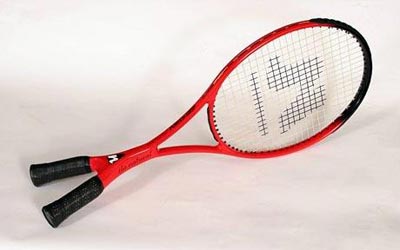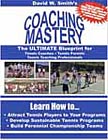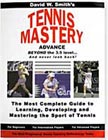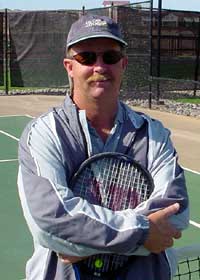|
TennisOne Lessons The Two-handed Forehand RevisitedDavid W. Smith, Senior Editor TennisOne
Turn the calendar back to the year 1974 – a boy had just turned 18 years of age and became the youngest French Open champion up to that time. But the age of the teenager was not the only noteworthy element of the event, that player, Bjorn Borg, had a two-handed backhand. Gasp! Borg was asked by reporters after his run at winning both the Italian Open two weeks prior then the French, "When are you going to switch to a one-handed backhand like everyone else uses?" I guess an equivalent remark would have been if reporters covering the 1968 Olympics would have asked Dick Fosbury when he was going to start jumping “normal” like the other jumpers do…after he won the high jump Gold Medal in those games.
Necessity is the Mother of Invention What does the two-handed backhand and high jumping have to do with an article on the two-handed forehand? Well, there is an historical correlation in play here, really. In virtually every generation prior to the current, you could have counted the number of two-handed forehand players on the professional tour on one hand…on one hand missing four fingers! Going back to Pancho Segura, we had really only seen a few two-handers on the forehand side (Gene Mayer comes to mind) until Monica Seles began to dominate the women's tour. At that time, women's tennis was going through a significant change in power, spin, and foot-speed relative to the generation prior where women like Evert, Austin, Goolagong, and virtually all other women, were serving first serves in the low 70's (mph), and rallies looked a lot like a slow-motion version of tennis today. As Seles, Capriati, the Williams sisters, and others emerged, the women's game no longer resembled a relatively leisurely game of backyard badminton; it evolved into more power, spin, aggressive shot making, and subsequently, the strategy of the game was changed.
However, I digress. Bring up the concept of a two-handed forehand and you are guaranteed to get a number of strange looks. When the great Wayne Bryan, father of Mike and Bob Bryan, the world’s current top doubles players, asked me what I was speaking about at a USPTA convention in Southern California about six years ago (where I was giving a lecture and workshop on the use of the two-handed forehand as both a learning tool and hitting weapon), his response was, “Don’t want it…don’t need it.” it was as if I were recommending that two hands on the backhand side might be a better way to hit a backhand! (In 1970!) Wayne was not alone in his sentiments.” The great Jack Kramer said essentially the same thing about the two-handed backhand in the late 1940’s, “It robs you of power and gives your opponent a psychological advantage.” Basically, Kramer was saying of the two-handed backhand the same thing Wayne Bryan said about the two-handed forehand…"Don’t want it, don’t need it." And certainly it is understandable, from one perspective, that such well-known and knowledgeable greats would not recognize something so foreign. As with a great number of pros, the two-handed forehand is as foreign as the Fosbury Flop was to high-jump coaches prior to 1968! Yet, today, we are seeing the second generation of two-handed forehand players emerging on the professional tour. One needs only to go back about fifteen years to see one of the pioneers of the shot at the high, professional levels, Monica Seles, to begin to see the correlation of the two-handed forehand to the history of the two-handed backhand.
Remember that beyond Connors, Borg, Evert and a bit later, Austin and Wilander, we didn’t really have another two-handed backhand player emerging onto the men’s or women’s professional scene for about 15 years, when players like Jennifer Capriati, Martina Hingis, and Lindsay Davenport (to name but a few) began to dominate the women's game. On the men’s side, Mat’s Wilander was eventually followed by a slew of two-handed players, including Agassi, Courier, Chang, Safin, and many, many others. But these players emerged a generation after the Borg/Connors era. Teaching Ignorance If pros teaching the sport know little to nothing about a stroke, they simply won’t–or don't know how to–introduce the shot or teach it effectively. Through out tennis history, it's been imaginative players who change the direction of the game. Other players then follow, then coaches figure out how to teach these innovations, like Sampras and the reverse forehand and Agassi and the swinging volley. (Whether Sampras and Agassi were actually the first to use these strokes is unimportant. They were, however, among the first to use them often and on a big stage.) Considering the shot is not widely taught in any sense, the fact that indeed there are a number of highly ranked pros using the two-handed forehand should tell us something right there. Obviously, someone is teaching the shot! And, conversely, some of their students are now taking the shot to the highest level. One needs only to look at the recent tournaments with France’s Marion Bartoli reaching the final of the BNP Paribas Open, (losing in three sets to champion and world’s #1, Caroline Wozniacki), and China’s Peng Shuai reaching the Quarters of the BNP, (losing in three sets to Sharapova), and both players reached the fourth round of the Sony Ericsson in Miami this past week.
Let’s face it, among the tens of thousands of juniors taking lessons today, the fact is, less than one percent will make it to the pros. Again, considering the few players being taught the two-handed forehand, and considering the tiny percent of players who make it to the pros, the fact that there are an increasing number of two-handed forehand players on tour is quite amazing. It find it interesting that one of the main arguments against teaching a two-handed forehand is the reach factor. It should be no surprise that this was the main argument against the two-handed backhand forty years ago! However, if you look at Bartoli and Peng, neither gal is particularly fleet footed, yet, they are competing very well against faster one-handed forehand players. Seles was never considered very quick either, and yet, she reached number one in the world with her two-handed forehand. If we were able to go back and teach the two-handed forehand to some of the top athletes on tour today, it would be interesting to see how far they might have taken the shot. The one-handed forehand is definitely still a weapon today The one-handed forehand is still a lethal weapon and certainly not all players would be better served with a two-handed forehand. However, there are a rising number of players on tour whose two-handed backhands are their more dependable–if not more potent–shots in their groundstroke bag. This is especially true on the women's side. Also, from a learning perspective, many players today are simply finding their one-handed shot is a bit too wristy, is over hit, has too big of a backswing, or is the source of most of their unforced errors. And, learning with two hands does not prevent one from developing a great one-handed forehand. I've taught hundreds of players a two-handed forehand. In every case, those who had a greater propensity to want to hit with one hand improved and progressed faster when learning the two-handed forehand first compared to similar students who were taught a one-handed forehand exclusively.
The fact that the two-handed forehand offers a great number of positive learning traits should be at the very least, one reason to consider teaching the two-handed forehand. Consider a player like Nadal, who first learned with two hands on both sides and what a great game he now has. This should be a little bit of a clue as to how this teaching idea works. Balance in Physical Movement There has been more and more talk recently about how players not only learn but also how some elements of the game are contributing to more injuries. One of those concerns is that players who use one hand on one side of their bodies and two hands on the other create a general imbalance in terms of muscle development and overall swing symmetry. There is a racquet now with two handles called “The Natural” which takes this concept and teaches players using the racquet how to swing with virtually identical balance on both sides of the body. This is a great tool which I believe will be seen more and more in the game. (The racquet is a legal stick in tennis.) But, from a conventional stance, a two-handed forehand with a conventional racquet helps in so many other ways too.
Two-handed Advantages More stability in the swing path – One of the biggest problems with any player's inability to improve and progress past certain levels is the problem with not being able to create a "regular, repeatable, and reliable swing path." Too much wrist, a swing path that changes from swing to swing, lack of control of the racquet face, are all problems that we often see players who learn or play with one hand. Shortened back swing – The dynamics of the forehand make players often take too big of a backswing. Because the backswing of the one-handed forehand has almost no limits, we see a great number of players swinging too big in too many situations…and often with no perception they are swinging too big at all! One common recommendation of teaching pros everywhere is, "Shorten your backswing!" Not coincidently, the best service returners are usually two-handers and they have very short backswings. The two-handed forehand naturally shortens the backswing also. The Unit Turn – As with most beginners, we try to teach the "unit turn," that is, instead of taking the racquet back with just the arm. The two-handed forehand is self-working in creating the unit turn. The player can't take the racquet back without the upper body at least making somewhat of a turn. Mimics the two-handed backhand – While there are a few differences between the two-handed forehand (cross-handed style) and the two-handed backhand, there is a great deal of similarity also. So, there is a more natural learning pattern when the student is using two hands on both sides instead of just on the backhand.
Natural topspin – Using the two-handed forehand model, imparting topspin on groundstrokes is more natural and easier. In fact, it was about twenty years ago when I first started teaching the two-handed forehand that I discovered this. It was out of frustration I had with a small group of beginning students who, for whatever reason, were having trouble executing topspin on the forehand side. I instinctively introduced them to the two-handed forehand and every student executed an incredible topspin forehand (relatively speaking!), which was my ‘ah ha’ moment as to how the shot works as a learning tool. Footwork – Another, almost "self-working," aspect of the two-handed forehand is the ability of players to hit closed, neutral, and open stances in a very short period of time. With two hands, I found players were far more balanced before, during, and after the shot. It was almost as if the two-handed forehand was a “governor” in terms of limiting them from over-swinging to the point of poor footwork or becoming off balance. Senior Players Advantages – In working with the Huntsman World Senior Games for many years, as well as having taught a great number of senior players over the years, I found that seniors have a wide range of problems associated with age. One of these issues was that stress to the joints and muscles were more pronounced and affected by tennis. Two-handed forehands offered not only a balance for the body in general, but two hands shared the stress of impact of the tennis ball on the racquet and subsequently to the joints and muscles of the body. Seniors who took on the two handed forehand often found they could not only play with far less pain, but could hit the ball much harder–while maintaining control!–than they could with one hand. Leaning to overcome stroke problems – One of the best learning components of the two-handed forehand is for players who obviously have a flawed or ineffective forehand. Any one-handed stroke modification is going to be so close to what they are used to doing that they will usually revert back to any bad or flawed habits because of this, especially during match play or when under duress. Two-handed strokes are different enough for the player so they can learn new swing components without reverting back. Yet, the two-handed strokes are so close to optimal one-handed strokes, the simple practice of the two-handed stroke for many will open the door and open their eyes to feeling something new within the stroke that they can now make a significant change in their one-handed stroke after working within a two-handed swing pattern for a period of time. Having another tool can make a world of difference We have all seen pros who simply don’t have an arsenal of learning tools in their teaching bag. While many can be very successful with only a certain teaching mantra or style, the fact is, there are students who will come along who don’t respond to even the best teaching method. So a pro who understands the logic and advantages of the two-handed forehand, even if he or she doesn’t necessarily prescribe to the shot as perhaps I do, the fact that they know how to introduce the shot and use it to help such students can make a world of difference for some. I had a teenage girl who had taken years of lessons at another club come to me with a horrible forehand stroke. (For whatever reason…I’m not saying they taught her wrong…she just didn’t ‘get it.’) We introduced her to a two-handed forehand and within two years, she was playing on a college team, and at a much higher level than she ever would have had she tried to continue with her flawed one-handed forehand. More players today are using the two-handed forehand, besides Bartoli and Peng, there is Akiko Morigami, Akiko Nakamura, Ayumi Morita, Zi Yan, and others who are on tour. Obviously, there are fewer men, but there have been a number in recent years to use the two-handed forehand with success: Fabrice Santoro, Jan Michael Gambil, and Rameon Sluiter come to mind. It will be interesting to see if the two-handed forehand continues to increase in numbers. More and more pros are seeing the shot for the values I’ve listed. The shot is being taught in Asian countries as well as Europe. The general consensus in the U.S. is like that of Wayne Bryan, however… “Don’t want it—Don’t need it.” Perhaps that will change in time! In part two, I'll discuss in more detail the two-handed forehand on the pro level.
Your comments are welcome. Let us know what you think about Dave Smith's article by emailing us here at TennisOne .
Dave Smith's Books on Tennis
Join thousands of tennis players and tennis teaching professionals who have mastered the game of tennis through two of the best-selling books on the game: David W. Smith's TENNIS MASTERY and COACHING MASTERY. Learn the "Advanced Foundation," the cornerstone to developing highly skilled players in both books. In Tennis Mastery, learn the philosophy, strokes, and strategies that David has used to train thousands of highly-skilled tennis players. In Coaching Mastery, discover the secrets to creating perennial championship teams and successful individuals. As one of the most successful tennis coaches in the U.S. Dave shares his secrets to building winning tennis teams and thriving tennis programs; he will show you how to train large numbers of players with minimal resources and how to attract and motivate players. Coaching Mastery is a must for every coach, tennis parent, and teaching professional. Get both books at: www.tenniswarehouse.com or www.coaching-mastery.com
David has taught over 3000 players including many top national and world ranked players. He can be reached at acrpres1@email.msn.com. |



 Your comments are welcome. Let us know what you think about this article by
Your comments are welcome. Let us know what you think about this article by